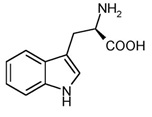Team:PrepaTec GarzaSadaMx/Summary
From 2012hs.igem.org
Fabiangarza (Talk | contribs) (→Summary) |
Fabiangarza (Talk | contribs) (→Summary) |
||
| Line 15: | Line 15: | ||
The triptófano and triptofanasa are already in the E. coli, so the next step is to insert a plasmid in the E. coli, which contains the gen to produce the enzyme ''[https://2012hs.igem.org/Team:PrepaTec_GarzaSadaMx/Protocols naftaleno diogenasa]''. To achieve this first we have to make ''[https://2012hs.igem.org/Team:PrepaTec_GarzaSadaMx/Protocols competent cells]'', then ''[https://2012hs.igem.org/Team:PrepaTec_GarzaSadaMx/Protocols transform the E. coli]'', and after that, we can recover the plasmid trough ''[https://2012hs.igem.org/Team:PrepaTec_GarzaSadaMx/Protocols electrophoresis]'' or ''[https://2012hs.igem.org/Team:PrepaTec_GarzaSadaMx/Protocols miniprep]'' in order to obtain the DNA we want. When we already have the enzyme naftaleno diogenasa, it turns the indole into 2,3 dihidroxindolina and in an spontaneous reaction with oxygen, we obtain indigo. After ''[https://2012hs.igem.org/Team:PrepaTec_GarzaSadaMx/Protocols obtaining indigo]'' we use a process called ''[https://2012hs.igem.org/Team:PrepaTec_GarzaSadaMx/Protocols halogenation of benzene]'' in order to get to the Tyrian purple. | The triptófano and triptofanasa are already in the E. coli, so the next step is to insert a plasmid in the E. coli, which contains the gen to produce the enzyme ''[https://2012hs.igem.org/Team:PrepaTec_GarzaSadaMx/Protocols naftaleno diogenasa]''. To achieve this first we have to make ''[https://2012hs.igem.org/Team:PrepaTec_GarzaSadaMx/Protocols competent cells]'', then ''[https://2012hs.igem.org/Team:PrepaTec_GarzaSadaMx/Protocols transform the E. coli]'', and after that, we can recover the plasmid trough ''[https://2012hs.igem.org/Team:PrepaTec_GarzaSadaMx/Protocols electrophoresis]'' or ''[https://2012hs.igem.org/Team:PrepaTec_GarzaSadaMx/Protocols miniprep]'' in order to obtain the DNA we want. When we already have the enzyme naftaleno diogenasa, it turns the indole into 2,3 dihidroxindolina and in an spontaneous reaction with oxygen, we obtain indigo. After ''[https://2012hs.igem.org/Team:PrepaTec_GarzaSadaMx/Protocols obtaining indigo]'' we use a process called ''[https://2012hs.igem.org/Team:PrepaTec_GarzaSadaMx/Protocols halogenation of benzene]'' in order to get to the Tyrian purple. | ||
| - | [[File:tryptophan_summary.jpg | + | [[File:tryptophan_summary.jpg|frame|Tryptophan]] |
</FONT COLOR> | </FONT COLOR> | ||
</div> | </div> | ||
Revision as of 20:58, 16 June 2012
Summary
The purpose of this experiment is to obtain Tyrian purple in a more environmentally friendly and efficient way than the one commonly used. The mollusk Bolinus Brandaris is killed in order to obtain this dye, thus we used the recombinant DNA techniques in order for the E. coli to produce Tyrian purple. We inserted two genes in E. coli for it to generate two enzymes which induce the reactions that produce indigo. After a chemical process, known as halogenation of benzene, indigo is turned into Tyrian purple. This process needs the usage of a catalyst called FeB3 in order for it to occur. Because we believe it´s essential that these species are kept from being endangered. The importance of this is related to the fact that it´s significant to maintain the biodiversity, as a way of preventing the disruption of the balance of the ecosystems.
This is a summary of the reactions occurring during the production of Tyrian purple:
Triptófano (triptofanasa) indol (naphthalene dioxygenase) 2,3 dihidroxindolina (O2 espontánea) indigo tyrian purple
The triptófano and triptofanasa are already in the E. coli, so the next step is to insert a plasmid in the E. coli, which contains the gen to produce the enzyme naftaleno diogenasa. To achieve this first we have to make competent cells, then transform the E. coli, and after that, we can recover the plasmid trough electrophoresis or miniprep in order to obtain the DNA we want. When we already have the enzyme naftaleno diogenasa, it turns the indole into 2,3 dihidroxindolina and in an spontaneous reaction with oxygen, we obtain indigo. After obtaining indigo we use a process called halogenation of benzene in order to get to the Tyrian purple.
 "
"
